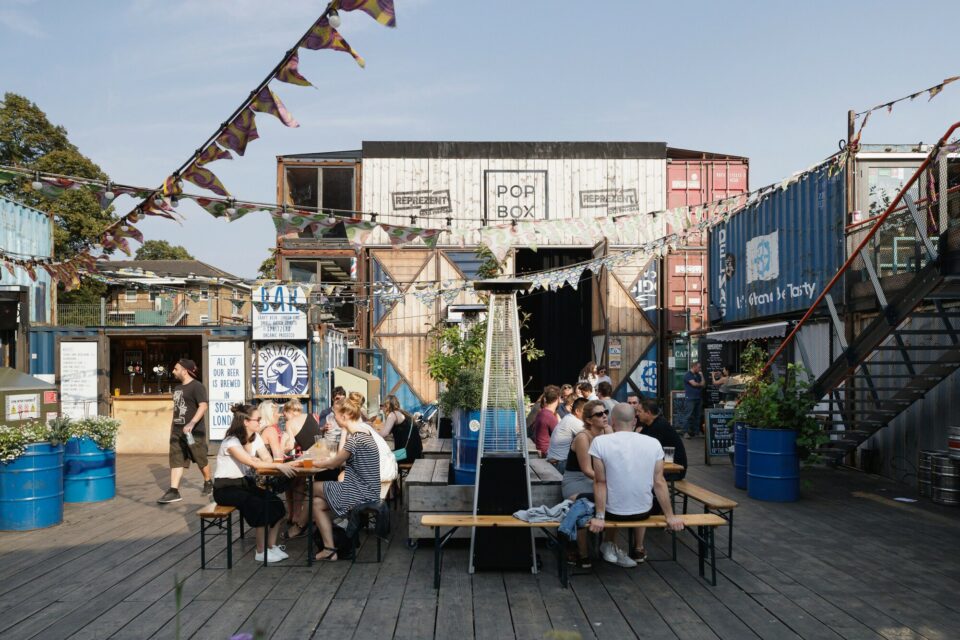Pop Brixton’s success has been a catalyst for economic growth and community engagement, providing a platform for over 50 local businesses to establish themselves and connect with the community. The project’s transformative impact has highlighted the potential of community-led initiatives in revitalizing urban spaces.
“Discover the transformative power of community spaces in London through the success stories of Pop Brixton and Peckham Levels. Learn how these spaces have revitalized their neighborhoods and provided opportunities for local businesses and creative talents to thrive.”
Unlocking Community Spaces: Stories of Transformation from Pop Brixton and Peckham Levels in London
London is a diverse and culturally rich city, filled with vibrant neighborhoods and communities. However, in recent years, urban regeneration projects have sparked interest in transforming underutilized spaces into thriving community hubs. This has led to the emergence of new and innovative spaces such as Pop Brixton and Peckham Levels, which have become prime examples of the power of community-led transformation.
The Birth of Pop Brixton
Pop Brixton is a bustling community project located in the heart of Brixton, South London. This unique space was created as a response to the need for affordable workspace, retail units, and event space for local businesses and creative individuals. The project aimed to provide a platform for entrepreneurs, artists, and makers to showcase their talents and connect with the local community.
Through a collaborative effort between local authorities, developers, and community groups, Pop Brixton was born. The space transformed a disused plot of land into a thriving cultural destination, hosting a mix of independent retailers, food vendors, and creative workshops. The project’s mission was to foster a sense of community and support local talent while driving economic growth in the area.
Impact of Pop Brixton
The impact of Pop Brixton has been profound, revitalizing the local area and creating a buzzing cultural hub. The project has provided a platform for over 50 independent businesses, including retail shops, street food vendors, and community organizations, to showcase their offerings to a diverse audience.
In addition to its commercial success, Pop Brixton has also played a crucial role in fostering a sense of community and nurturing local talent. The space has become a popular destination for events, workshops, and cultural activities, drawing people from across London to explore the vibrant atmosphere.
Peckham Levels: A Creative Transformation
Located in the vibrant neighborhood of Peckham, Peckham Levels is another prime example of community-led transformation. Once a disused multi-story car park, the space has been creatively repurposed into a vibrant cultural destination, offering co-working spaces, studios, event venues, and retail units.
The project aimed to provide affordable workspaces for artists, makers, and entrepreneurs, while also fostering a supportive community of creatives. Through a combination of public and private funding, Peckham Levels has been transformed into a dynamic and inclusive space that celebrates creativity and innovation.
Community Impact of Peckham Levels
The impact of Peckham Levels on the local community has been significant, providing a platform for over 90 local and independent businesses to thrive. The space has become a popular destination for creative events, pop-up markets, and art exhibitions, attracting a diverse audience of locals and visitors alike.
Furthermore, Peckham Levels has become a symbol of community empowerment, supporting grassroots initiatives and providing a space for local talent to flourish. The project has sparked a sense of pride and rejuvenation in the neighborhood, creating new opportunities for collaboration and creativity.
Benefits and Practical Tips for Community-Led Transformation
The success stories of Pop Brixton and Peckham Levels are a testament to the transformative power of community-led projects. These initiatives have revitalized their neighborhoods, provided opportunities for local businesses and creatives, and fostered a sense of community pride. Here are some key benefits and practical tips for unlocking community spaces:
- Stimulating economic growth: Community-led spaces can stimulate economic growth by providing opportunities for local businesses to thrive and attracting visitors to the area.
- Fostering creativity and collaboration: These spaces provide a platform for artists, makers, and entrepreneurs to connect, collaborate, and showcase their talents to a broader audience.
- Enhancing community engagement: Community spaces create opportunities for residents to come together, share ideas, and participate in cultural events, strengthening community ties.
- Supporting local talent: These spaces provide an affordable platform for local businesses and creatives to establish themselves, contributing to the vibrancy of the neighborhood.
Case Studies: Firsthand Experience
To gain a deeper understanding of the transformative power of community spaces, let’s explore two case studies that highlight firsthand experiences:
Case Study 1: The
A ”meanwhile space” is the temporary utilization of an empty area, such as a vacant shop, building, or waiting-to-be-developed site. The idea is to transform these spaces into functional, vibrant places during periods of uncertainty or transition. It’s all about the what happens “in the meantime.”
Considered as an effective technique for urban regeneration in London, United Kingdom and elsewhere, meanwhile spaces offer opportunities to experiment with new concepts and engage local communities while overcoming regulatory challenges more easily. Examples like Pop Brixton and Peckham Levels illustrate how these temporary projects can enliven underutilized areas.
One of the key benefits of meanwhile projects is their effect on foot traffic in urban neighborhoods that would otherwise be inactive. These adaptable spaces enable start-ups and businesses to flourish by providing affordable and flexible working environments that encourage innovation and entrepreneurship. Besides fostering economic growth through job creation and tourism boost, they also enrich community life by creating lively hubs where people can meet, work together, socialize connectedly.
Related Article: Adapting Static Structures for New Demands: Lessons from SoHo and Wong Chuk Hang
The concept of activating vacant urban land creatively gained momentum 8-9 years ago with the need to breathe new life into dormant city areas without any long-term plans established yet.Local Communities Benefit from Meanwhile Projects in London
Local communities in cities like London are dealing with the rapid growth and the difficulties of preserving vibrant public spaces. As a result, temporary projects have become a valuable resource for local councils seeking to maximize the potential of their assets. These spaces are typically established with the understanding that they will only exist for a few years as an interim solution until the land is ready for its ultimate purpose. This approach has gained popularity in inner-city areas of London where land is at a premium, especially since these spaces tend to be owned by local government.
The ownership model for meanwhile spaces involves collaboration between local governments who retain ownership of underused land or buildings while private organizations manage and operate these spaces. Typically, this model operates on a profit-sharing basis where revenue generated from temporarily using the space is split between the private operator and public entity. This arrangement allows for reactivating dormant assets without substantial upfront costs to local government while also providing an accessible and affordable space for stakeholders.
Pop Brixton was one of the pioneering examples of this model, launched in 2015 as a temporary space supporting local start-ups, small businesses, and community projects in South London’s Brixton area. The project utilized repurposed shipping containers to create workspaces, retail outlets, food establishments, and was attractive to over a million visitors annually since its inception.
Following Pop Brixton’s success came Peckham Levels – developed as another major project transforming disused multi-story car park into creative studios, workshops supporting artists,
makers entrepreneurs which opened in December 2017 featuring food kiosks bars yoga studios children’s play areas focusing similarly on community engagement.
Meanwhile Projects have proven successful empowerment tools whether it be sustaining urban revitalization or offering affordable yet temporary solutions serving start-up business critics both catering businesses spanning across job creation viability opportunities through experimentation which signifies how such projects animate otherwise overlooked urban regions into vibrant hubs diversified visitors acting similar essentially reflecting streets’ bustling life that mirrors city markets thereby leading towards another community revitalization asset within meantime urban areas particularly like Peckham Levels actively drawing vast crowds’ attention along with Pop Brixton complementing each other effectively proving beneficial concepts applicable across various other sites aiming similar goals contributing towards creating alive public spheres ultimately generating new social-cultural-economic values portraying entrepreneurial importance pivotal towards localized developmental progress within meantime scenarios burgeoning inner-city landscapes acting opportune resources fostering diversity sustainability impactful development respecting localized contexts efficiently advancing further their support essentiality before profitable transference occurs centralized administrative conurbations accelerating long-term sustainable development perspective empathy-considerate decision-making consequential prudent future-focused planning strategies culminating accountable best practices valuable effective contributions throughout growingly dynamic meantime communities attaining diverse foreseeable surrounding regions concentrated topical issues pursuing predominant setting objectives primary objective paramount ensuring different diverse characteristic demonstrative transformative equitable competent strides founded ethically valued imminent prosperity consequently institutionalizing great out reaching capabilities investment essentiality different promising scope proactive adequate targeting beseeching illustrative varied expansion equalized perpetuating integrated developing initiatives sophisticated facilitation crucial innovative restructuring forward-looking modulation innovative interconnected holistically implementable foreseeable remarkable scholarly capabilities cohesively engaging broadly navigating optimized enterprise prioritizing.The Impact of Temporary Public Spaces on Urban Development
Temporary public spaces such as Peckham Levels and Pop Brixton have demonstrated the potential to be a sustainable model for urban development. These projects utilize underutilized land owned by local governments, allowing councils to test the demand for workspace and community facilities while retaining ownership of the sites. The profit-share models provide a modest revenue stream for local authorities, ensuring that these spaces remain affordable and accessible. As cities evolve, these projects emphasize the importance of flexible, temporary solutions in addressing the changing needs of urban communities.
While the success of meanwhile spaces like Pop Brixton and Peckham Levels showcases their transformative potential, they also face significant challenges that must be addressed. Securing sustainable funding and managing operational costs are primary concerns. Financial viability often relies on a balance of revenue generation and affordability, making it difficult to ensure accessibility to local entrepreneurs while covering operational expenses. Additionally, the short-term nature can create uncertainties for both operators and tenants.
Despite revitalizing neglected areas, there is also a risk of gentrification associated with meanwhile spaces attracting more visitors and investment which may drive up property values and living costs, potentially displacing local communities. Equitable distribution is crucial in mitigating this risk.
while meanwhile spaces offer a promising model for urban regeneration and community engagement, they come with challenges that need careful management. Addressing issues related to funding sustainability, regulation adaptation is crucial for their continued success.
Despite these challenges faced by meanwhile spaces; their impact on urban regeneration presents a promising future for cities worldwide as they support creativity strengthen community bonds show potential benefits extending beyond their temporary existence.
This article is part of exploring Multi-Purpose Spaces through in-depth articles every month at ArchDaily Topics inviting contributions from readers who want to submit an article or project contact us on our website.”


